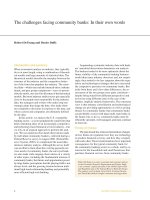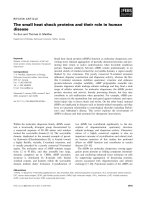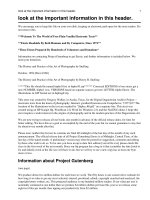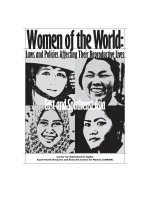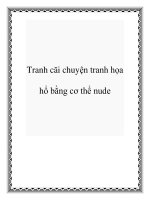Lighting the nude top photography professionals share their secrets
Bạn đang xem bản rút gọn của tài liệu. Xem và tải ngay bản đầy đủ của tài liệu tại đây (12.07 MB, 217 trang )
CONTENTS
ABOUT THIS BOOK 6
HOW TO USE THIS BOOK
8
CHAPTER ELEVEN
GLOSSARY OF LIGHTING TERMS
10
CHAPTER TWELVE
TEXTURES, PATTERNS AND FORMS
212
FETISH APPEAL
232
CHAPTER THIRTEEN
NUDES
13
CHAPTER ONE
APPROACHING NUDITY
16
CHAPTER TWO
THE ROMANTIC LOOK
250
CHAPTER FOURTEEN
PUSHING THE BOUNDARIES
274
PROVOCATIVE SHOTS
292
CLASSICAL NUDES
CHAPTER FIFTEEN
36
SIMPLY NAKED
CHAPTER THREE
296
THE SEMI-DOMESTIC NUDE
CHAPTER SIXTEEN
58
HAIR AND MAKE-UP
CHAPTER FOUR
314
FANTASIES
CHAPTER SEVENTEEN
74
STRIKING A POSE
CHAPTER FIVE
330
MALE NUDES AND COUPLES
CHAPTER EIGHTEEN
96
PROPS
CHAPTER SIX
352
THE OUTDOOR NUDE
CHAPTER NINETEEN
114
EFFECTS AND FINISHING
CHAPTER SEVEN
372
SYMBOLS AND EXPERIMENTS
CHAPTER TWENTY
130
DRESSING UP
EROTICA
150
CHAPTER EIGHT
EROTIC FANTASY
154
CHAPTER NINE
ABSTRACTS AND BODY PARTS
394
CHAPTER TWENTY-ONE
VOYEURISTIC SHOTS
412
DIRECTORY OF
PHOTOGRAPHERS
434
176
ACKNOWLEDGMENTS
CHAPTER TEN
448
ACCESSORIES AND PROPS
194
ABOUT THIS BOOK
The most common response from the photographers who contributed to this book, when the
concept was explained to them, was "I'd buy that". The aim is simple: to create a library of
books, illustrated with first-class photography from all around the world, which show exactly
how each individual photograph in each book was lit.
HOW TO USE THIS BOOK
The lighting drawings in this book are intended as a guide to the lighting set-up rather than as
absolutely accurate diagrams. Part of this is due to the variation in the photographers' own
drawings, but part of it is also due to the need to represent complex set-ups in a way which
would not be needlessly confusing.
Distances
and
been
further away, and so forth, according to the
practicalities, and the way of the world
compressed and expanded: and because
needs of the shot. Likewise, the precise
in general.
of the vast variety of sizes of soft boxes,
power of the individual lighting heads or
The book can therefore be used in a
reflectors, bounces and the like, we have
(more important) the lighting ratios are not
number of ways. The most basic, and
settled
always given; but again, this is something
perhaps the most useful for the beginner, is
conventionalized symbols. Sometimes, too,
which
to
we have reduced the size of big bounces,
photographer wishing to
just to simplify the drawing.
lighting set-ups in here. We are however
particularly
None of this should really matter, however.
confident that there is more than enough
lighting diagrams, and to try to duplicate
After all, no photographer works strictly
information given about every single shot to
that shot as far as possible with the
according to rules and preconceptions:
merit its inclusion in the book: as well as
equipment available.
there is always room to move this light a
purely lighting techniques, there are also all
A more advanced use for the book is as a
little to the left or right, to move that light
kinds of hints and tips about commercial
problem solver for difficulties you have
closer or
realities, photographic
already encountered: a
on
even
a
sizes
limited
have
range
of
can
be
"finetuned"
by
any
reproduce the
study
all
the
technical
information
concerning a picture which he or she
admires,
together
with
the
particular
technique
of
back-
The following is a key to the symbols used in the three-dimensional and plan view diagrams.
lighting, say, or of creating a
All commonly used elements such as standard heads, reflectors etc., are listed. Any special
feeling of light and space. And, of
or unusual elements involved will be shown on the relevant diagrams themselves.
course, it can always be used
THREE-DIMENSIONAL DIAGRAMS
simply as a source of inspiration.
The
information
for
each
picture follows the same plan,
though some individual headings
may be omitted if they were
irrelevant
or
unavailable.
The
photographer is credited first, then
the client, together with the use for
which the picture was taken. Next
come the other members of the
team who worked on the picture:
stylists,
models,
art
directors,
whoever. Camera and lens come
next, followed by film. With film,
we have named brands and types,
because different films have very
different ways of rendering colours
and tonal values. Exposure comes
next:
where
the
lighting
is
electronic flash, only the aperture
is given, as illumination is of
course
speed.
independent
Next,
the
of
shutter
lighting
equipment is briefly summarised
— whether tungsten or flash, and
what sort of heads — and finally
there is a brief note on props and
backgrounds. Often, this last will
be obvious from the picture, but in
other cases you may be surprised
at what has been pressed into
service, and how different it looks
from its normal role.
The most important part of the
book is, however, the pictures
themselves. By studying these, and
referring to the lighting diagrams
and the text, you can work out how
they were done.
NUDES
From the very earliest days of photography, and indeed from the earliest days of
representational art, the portrayal of the nude and partially nude human form has exercised an
enduring fascination. By the early 1850s there were numerous daguerreotypists in Paris in
particular who were noted for their photography of the nude: Auguste Bellocq, Bruno
Braquehais, Jean-Louis-Marie-Eugene Durieu, F. Jacques Moulin, Louis Camille d'Olivier and
more.
much guidance as possible on how to
our own times it becomes harder and
photograph the
harder
nude -
which for
our
to
recognize
underlying
trends.
Some of this early work was nothing more
purpose includes the partially nude, as a
There also seems to be more diversity than
nor less than pornography, but co-existing
book containing nothing but total nudity
ever before. In this book there are very
with this was an artistic tradition which
would be more use as an anatomy book
simple studio nudes, shorn of context or
stretched
than as a book on photography. We have
with only the simplest of backdrops, but
thousands of years: a representation of a
drawn
there
nude can after all be attractive without
numerous countries, all with their own
naturalistic)
being
unique styles and ways of working. Our job
buildings;
pornographic. What is surprising, to the
has been merely to learn from them how
photographed
modern eye, is how many of the early
they work, to organize that information, and
romanticism, or in the grittiest of realism.
photographers seem to have made no
to make it as useful and informative as
Unlike the case of some other books in the
particular distinction: Moulin, in particular,
possible.
PRO LIGHTING series, generalizations are
back
erotic,
hundreds
or
erotic
or
without
even
being
work
from
photographers
from
produced some quite charming pictures,
Studios and Settings
admirers would be hard pressed to defend
It
on aesthetic grounds.
unfortunately, it would
photography:
out
of
with
in
natural
in
doors
(or
abandoned
and
the
indoors;
utmost
in
might
have
is one of the most intensely personal forms
been
useful
-though,
not have
of photography.
been
practical - to include a chapter of historical
Photography and Painting
are
images in this book. It could have begun
More than in almost any other area of
with the static nineteenthcentury nudes in
photography,
doubt many who would like to see even this
their stuffy studios;
on to the
photographed nude and the painted nude is
book burned, while there are others who
Edwardians, with their naturalistic studio
abundantly clear, and the photographer
will be unable to see why a single image in
sets and locations; then gone on to the
who looks only at the works of other
here
period between World War One and World
photographers and ignores the works of
depravity, is something which is easier to
War Two, the heyday of the geometrical
painters is making a serious mistake. There
recognize than to define.
nude and the semiabstract "figure study";
are pictures in these pages which are
This is not, however, the place for such a
taken in the 1950s, with their emphasis on
reminiscent
debate. Nor is it the place for a discussion
the outdoors, and the 1960s with their gritty
Hockney and even Liechtenstein. A tour of
of
photo-realism;
any art gallery, or a few books on painting,
why
upset
individual
pictures
nudes
settings;
"acceptable", and to whom. There are no
could
which
also
very hard to make: photographing the nude
and others which even his most ardent
This is the central problem in all nude
are
anyone.
Art,
photographers
pictures of nudes. You have
like
take
presumably
bought the book, or you are contemplating
buying it, and so it is our job to give you as
which
and
characterized
moved
the
so
selfindulgence
much
of
1970s...
Of course, as we come nearer to
the
the
of
link
between
Alma-Tadema,
the
Balthus,
can be worth as much as a visit to a
photographic gallery, even if it is showing
the works of an
acknowledged master such as Bill Brandt,
timeless-looking young girls with long hair
simply maintain that it gives them more
Helmut Newton, or Jock Sturges.
are
photographers.
control and better enables them to realize
Another is that gravity has taken less of a
their personal photographic vision. There
toll of their figures.
seems to be no overall preference for a
Clothes, Props and Make-up
often
preferred
by
particular type or even brand of black and
As already remarked, the totally unclothed
nude is unusual; and there is quite a lot of
Cameras, Lenses and Film for
white film, and Stu Williamson makes a
fashion and personal originality in what he
Nudes
particular point of using a wide range of
or she may be clothed with. Diaphanous
Commercially, roll-film cameras have it all:
monochrome films for different tonal
draperies were always popular with the
they offer a bigger image than 35mm, with
effects.
painters of yore, and, within the bounds
commensurately better quality, and the old
imposed
argument of "big fee - big camera" has a
Lighting Equipment for Nudes
certain logic to it.
Yet again, generalizations are impossible:
by
the
greater
literalness
of
photography, the same may also be found
in these pages: lengths of fabric, and even
What is interesting, though, is how
sheets, are pressed into service on a
many photographers choose 35mm for their
there are not even any particularly common
regular basis. More conventional clothes
personal work. In particular, even when
lighting set-ups. In these pages you will find
may be partially undone, or underwear may
Struan has been shooting commercially
everything from available light to monster
be revealed, or clothes normally regarded
with his Hasselblad, he may switch to
soft boxes to on-camera flash, taking in a
as essential for decency may be omitted.
35mm for his personal shots, several of
number of quite complex lighting setups on
which
the way. A basic kit would probably consist
When
it
comes
to
props
and
appear
in
here.
Likewise, Julia
unlike (for example) food or pack shots,
backgrounds, there is a long tradition of
Martinez said of one set of pictures (of
of three heads, two of which would be
geometrical or semi-abstract nudes, where
which two appear in this book), "I was just
used for lighting the background, though
props normally look out of place; but there
working with 35mm, and the freedom was
everything from single-light pictures to
is no doubt that in the vast majority of nude
wonderful; no big, heavy cameras and no
those using four or five lights will be found
studies props are an essential part of the
lights to move around. The model felt more
in this book. It is also worth mentioning Stu
picture. This is true whether you are
relaxed, too."
Williamson's ingenious Tri-Flector, which is
considering
of
Going in the other direction, very few
Michele Francken or the almost apocalyptic
the
photographers shoot large format nudes
intensity
Williamson's
any more, although there is a handful of
shoot nudes only by available light; you will
pictures; and in one of Struan's most
4x5in shots in this book. Longer-than-
find plenty of examples of these, too.
notable
is
standard lenses are very much the norm,
essentially a prop because the picture was
although there are also plenty of wide-angle
The Team
commissioned
shots in the book: Struan with 35mm and
Most photographers of the nude work on
even 28mm on 35mm, Guido Paterno
their own most of the time. There are two
Castello
main reasons for this. The first is simple
of
irreverent
some
pictures,
of
the
as
Stu
model
an
humour
herself
advertising
photograph for a shoe.
As for hair and make-up, this is
something which dates far faster than most
people
(especially
most
men)
with
50mm
on 6x6cm,
Peter
Goodrum with 90mm on 4x5in.
realize.
As
for
films,
a
described more fully on page 24.
And, of course, many photographers
economics: a lot of nude photography is
surprisingly
high
done for personal or portfolio work, and the
Examples like the old "beehive" hairdo are
proportion of pictures in this book were shot
budget simply does not stretch to an
obvious, but compare the heavy eye make-
on black and white – or perhaps it is not
assistant. There are exceptions, as when a
up and often unnatural but often dramatic
quite such a surprise, given the way in
personal shot is grafted onto a
lipsticks
of
the
1960s
with
the
more
which so many photographers shoot nudes
commissioned shoot, but this is the
naturalistic eye-make-up and washed-out
for
exception rather than the rule. The other
lipsticks of the late 1970s and early 1980s.
photographers
This is one reason why
suspicion that monochrome is more "real"
fun,
rather
than
still
for
have
than colour, while others
profit.
a
Many
sneaking
reason is that nude
photography requires
a certain rapport
d'Antibes most certainly does not go in the
between the subject and the model, and it
Bois de Boulogne. Finally, remember this.
is often difficult to establish that rapport if a
More than most kinds of photography,
third person is present. On the one hand,
taking pictures of nudes is a matter of
the third person may reassure the model –
mood. That mood may be timeless, or
this is especially true if the third person is of
deliberately confrontational, or erotic, or
the same sex as the model - on the other,
innocent, or a hundred other things; but if
he or she may seem like an intrusion: the
the mood you want is not the same as the
photographer is, as it were, licensed to see
mood you are getting, this more than
the model in the nude, but other people are
anything else will stop you taking the
not.
pictures you envisioned.
The Nude Photography Session
Because nude photography is so intensely
personal, and because models vary so
widely in temperament and attitude, only a
few general remarks are appropriate.
The most important ones concern the
facilities for the model. She should be able
to dress and undress in privacy, because
nude modelling is not the same as doing a
strip-tease. This privacy can be a changing
room, or a car with a sheet draped over the
windows and weighted or taped down at
the corners. She should be able to keep
warm between shots: a clean, soft blanket
is a useful thing to have to hand. She
should
of
course
have
been
warned
beforehand not to wear tight clothing, as
marks on the skin can take hours to
disappear. Other people should be xcluded
as far as possible, though a few models
seem to be born exhibitionists and deliver
their best work in front of a large and
appreciative audience. In some countries,
or in some locations, there may be a
problem with public nudity. At the very
least, this can make a shoot awkward, and
at the worst it may involve arrest or assault
or both. If you are in an unfamiliar country,
check local mores as far as possible - and
remember, what goes in San Francisco
may not go in Kansas, and what goes at
the Cap
Scan by Anton KlimoFF
Photographer: Michele Francken
Client: Mac 3 Company
Use: Advertising
Camera: 6x6cm
NUDE
Lens: 110mm with Softar screen
Film: Kodak Ektachrome EPP 100
Exposure: f/8
Lighting: Electronic flash: I head
Props and set: Hand-painted backdrop
Plan View
.
Pointed backdrops can be
graded,or may give the
impression of being spotlit
Some photographers paint their
own, but there are
manufacturers who specialize
in custom or unusual backdrops
LIGHTING IS SUBJECT TO OCKHAM'S RAZOR: LIGHTS (LIKE LOGICAL ENTITIES)
SHOULD NOT BE MULTIPLIED WITHOUT REASON. HERE A SINGLE LIGHT SUFFICES
TO CREATE A MEMORABLE PICTURE. NOT EVEN A BOUNCE IS USED TO
SUPPLEMENT THE LIGHTING PLOT.
The backdrop is however a little unusual.
more
more variation in tone. The apparent The
drawback to such a background is that it is
model's
monotonous - but this is only the case for the
shadow
is
just
about
visible
variation
in
tone.
photographer,
the
is
normally see only their own picture against
monotonous - but this is only the case
that ground. Also, considerable differences
seems brightly spotlighted. This is for the
can be effected, depending on where the
photographer,
subject is placed against the "hot spot."
left,
yet
the
because
background
the
normally
the
apparent
drawback to such a background is that it to
lower
because
The
subjects
achieved with additional lighting, subjects
normally see only their own but another way
to do it is to have a picture against that
ground. Also, backdrop which is painted as if
.
The effects obtainable with a
ainted backdrop can vary
widely depending on the
subject's distance from the
backdrop, the lighting of the
backdrop, and the aperture
employed
it were considerable differences can be
effected, spotlit: in other words, it is painted
in
depending
on where the subject
is
somewhat the same way as a graded placed
against the "hot spot." background, but less
smoothly and with
Photographer's comment:
This sort of lighting is used to create a more sensuous express/on. A Softar filter is used to
soften the skin.
Photographer: Bob Shell
Use: Personal work
Model: Audra Fregia
Camera: 645
Lens: 80mm
A U D R A AT T H E W I N D O W
Film: llford FP4
Exposure: 1/60 sec at f/8
Lighting: Available light
Plan View
PERHAPS THE MOST IMPORTANT THING TO NOTE HERE IS THAT THE WINDOW IS
COVERED WITH FROSTED MYLAR, MAKING IT A NATURAL SOFT BOX AND ALSO
MAKING IT OPAQUE SO THAT THE MODEL CANNOT BE SEEN FROM THE STREET.
This
·
Frosted Mylar and Kodatrace re
bot/I superb diffusion materials,
but in colour Kodatrace
introduces a very slight green
Cast
·
There is a significant difference
between a window receiving
direct sun (like this one, which
faces north-west) and a window
which is illuminated only by
skylight
sort
of
silhouette,
combined
with
curtains and the lace of the peignoir is
transillumination of the peignoir, can be
doubly
extremely
effective
while
still
effective.
Flare
is
of
course
a
showing
potential problem and unless the intention is
remarkably little that could offend any but
to make a feature of it, the lens must be
the most prudish viewer. The shape of the
scrupulously clean; even then, there is some
model is beautifully illustrated, and the
evidence of flare around the model's fingers.
contrast between the lace of the
Photographer: Ron McMillan
Client: Beauty Products Catalogue
Use: Catalogue
Model; Emma Noble
Assistant: Paul Cromey
EMMA
Camera: 6x6cm
Lens: 120mm + Softar II soft-focus
Film: Kodak Panther XI00
Exposure: f/16
Lighting: Electronic flash: 2 striplights
Props and set: Seamless background
•
»
_5
tO>
~y
Plan View
OFTEN, A NUDE SHOT FOR ADVERTISING MUST REVEAL VERY LITTLE; IT MUST
LOOK NATURAL AND CHARMING, BUT NOT REVEALING. THIS IS A TIMELESS
PICTURE WHICH MIGHT ONCE HAVE SEEMED RISQUE BUT WHICH IS ENTIRELY
ACCEPTABLE IN THE LATE 20TH CENTURY.
·
·
Strip lights are more directional
than soft boxes, at least in the
short axis
This is on interesting example
of white-onwhite; the towel is
lighter than the background on
the left, and darker than the
background on the right
The lighting is certainly simple: a vertical
side-light.
strip light to camera left, illuminating the
complexity of the lighting which is important,
model's back and a horizontal strip light on
but its appropriateness; and analyzed more
the floor behind the model, illuminating the
carefully, this profile semi-high-key approach
background and in the process providing a
is unusual and effective. The use of a white
modest amount of fill on the model's arm
towel on the dark side of the model, away
and on the towel. Compared with the model,
from the light, saves it from being too dark
the vertical light is very slightly nearer the
as well as suggesting natural, unaffected
camera, to provide a glancing light rather
beauty.
than a pure
As
so
often,
it
is
not
the
Photographer: Stu Williamson
Client: Andrea (model)
Use: Portrait
Camera: 6x7cm
Lens: 140mm
ANDR EA
Film: Word FP4
Exposure: f/11
Lighting: Electronic flash: one head
Props and set: Lastolite "Thunder"
painted backdrop
OFTEN, A NUDE SHOT FOR ADVERTISING MUST REVEAL VERY LITTLE; IT MUST
LOOK NATURAL AND CHARMING, BUT NOT REVEALING. THIS IS A TIMELESS
PICTURE WHICH MIGHT ONCE HAVE SEEMED RISQUE BUT WHICH IS ENTIRELY
ACCEPTABLE IN THE LATE 20TH CENTURY.
Plan View
This light is well above the model and to
directed with considerable precision. The
camera right, as may be seen from the
picture
shadows; but Stu also used his trademark
dodging - Stu prints all his own work -and
"Tri-Flector" (which he invented and which is
the pink colour was added with Fotospeed
manufactured
dyes. The shaped background is more an
by Lastolite). This has
a
central panel flanked by two "wings" which
·
Large reflectors give a
different quality of light
from soft boxes
·
Hand colouring can add
impact to a monochrome
nude
·
The contrast between
tanned and untanned
areas (if the model has not
got an overall tan) can be
used to good effect in
some shots
was then
printed
with
dramatic
effect of printing than of lighting.
allow the light to be
Photographer's comment:
The model wanted a picture for her boyfriend. It had to be intimate and revealing without
being too revealing
Photographer: Stu Williamson
Client: Tanya
Use: Portrait
Camera: 6x7cm
Lens: 90mm
TANYA
Film: llford Pan F
Exposure: f/11
Lighting: Electronic flash: 4 heads
Props and set: Colorama hand-painted
b/g; crown by Terry English,
armourer
THE MODEL IS SURPRISINGLY FULLY CLOTHED, BUT BECAUSE OF THE WAY THE
"CLOTHES" ARE ARRANGED, SHE LOOKS LESS DRESSED THAN SHE IS. THE SEMICLASSICAL POSE AND BACKDROP CONTRIBUTE STILL MORE TO THE OVERALL
AURA OF SENSUALITY.
The lighting is of course important too. The
illumination of the background, which is also
key is the honeycombed spot to camera left,
lit with a fourth head coming in from camera
above the model's head, illuminating (in
right.
particular) her face
supplemented
.
.
If a single light will not do what
you wont, ask yourself what it
would illuminate if it were doing
what you want
by
and chest. This is
another
This is a good example of a second light
honeycombed
being added to the key to create the illusion
head to camera right, rimlighting the model's
of one light: the key and the rimlight combine
legs. A large soft box, just above the
flawlessly, creating the impression of a.
camera, acts as a general fill and provides
single light source.
some of the
Painted backdrops can have
more than one centre of interest
- or two backdrops can sometimes
be combined
Photographer's comment:
I use o wide variety of different black and white films for different tonalities.
Photographer: Julia Martinez
Use: Personal work
Model: Becky
Camera: 645
Lens: 300mm
Film: Kodak T-Max 100
R E C E S S IO N
D R E S S
ING
Exposure: f/11
Lighting: Electronic flash: 3 heads
Props and set: White background - and
see
Plan View
·
Chiaroscuro and high key are
less incompatible than they
might seem
JULIA MARTINEZ WAS AT FIRST BEST KNOWN FOR HER GENTLE AVAILABLE-LIGHT
PICTURES BUT, AS THE PHOTOGRAPHS IN THIS BOOK SHOW, SHE IS ALSO QUITE AT HOME
WITH OTHER LIGHT SOURCES - IN THIS CASE STUDIO FLASH.
The key and indeed only light on the subject
mage was toned blue using Fotospeed
is a 120x 120cm (4x4ft) soft box to camera
materials.
right, beside the model. Two bounces, one
The overall effect is classical and simple.
to camera left and the other below the
It illustrates, as do most good pictures, that
camera's line of sight, even out the light
the
considerably while still maintaining strong
photographer's
modelling. Finally, a couple of lights on the
framed this way? Would you have framed it
background create a classic high-key effect.
this way? And why does it "work" so well?
single
most
important thing
eye.
Why
is
the
is the
image
The printed
·
Some photographers' style is
intimately bound up with their
lighting technique; others are
more recognizable from their
compositional approach
Photographer's comment:
This was shot for a college assignment on "recession dressing". The necklace is made of
Coca-Cola can pulls....
Photographer: Frank P. Wartenberg
Use: Portfolio
Camera: 35mm
Lens: 85mm
Film: Polaroid Polagraph
LATE SUN
Exposure: Not recorded
Lighting: Late sun
Props and set: Location (beach)
Plan View
·
·
With a high-contrast material,
the important thing is to know
exactly which tones to expand
Polaroid instant-process 35mm
films have very tender
emulsions and should only be
sent out as dupes
MANY PHOTOGRAPHERS USE POLAROID POLAPAN FOR ITS UNIQUE AND RATHER
OLD-FASHIONED TONALITY - WHICH IS OFTEN MORE IMPORTANT THAN "INSTANT"
PROCESSING -BUT THE MORE EXPERIMENTALLY MINDED HAVE DISCOVERED JUST
WHAT ITS HIGHER-CONTRAST COUSIN, POLAROID POLAGRAPH, CAN DO.
Frank Wartenberg is particularly fond of this
Exposure must however be very precise if
film and as he demonstrates here, there is
the highlights are not to be "blown" or the
no need to take seriously the warning that it
shadows too extensive. Like any high-
is
general-purpose
contrast product, it can be used to expand
photography. Even in the relatively contrasty
not
any part of the tonal range at the expense of
conditions of direct sunlight, it can deliver an
both lighter and darker areas; and this is
excellent
what has been done here
subtlety.
intended
tonal
for
range
and
remarkable
Photographer: Struan
Use: Personal work
Model: Krista
Camera: 35mm
Lens: 105mm
JEANS
Film: Kodak Tri-X Pan
Exposure: 1/25 sec at f/4
Lighting: Available light
Props and set: White studio wall
Plan View
THIS SUCCESS OF THIS PICTURE DERIVES IN LARGE PART FROM ITS
PLAYFULNESS. THE MODEL IS DEFINITELY "STRIKING A POSE", BUT THE WOOLLY
GLOVES TURN HER INTO A REAL PERSON RATHER THAN JUST A SYMBOL.
Time and again the virtues of our ancestors'
sunny day and the windows are in exactly
daylight studios are revealed: a traditional
the right place; you need a large studio, in
daylight studio with skylights and blinds is
order to take the greatest advantage of light
not to be sniffed at. This picture is lit from a
from different directions; light intensity can
skylight on an overcast day.
vary rapidly as clouds blow across the sun;
On the minus side, daylight is less
·
Daylight is a wonderful medium
but hard to control
·
Because of its colour, north
light is often of more use in
monochrome than in colour
·
Contrast what people expect
with what they don't expect, for
arresting effect
versatile and controllable than artificial light
There are no spotlights. unless it is a
and light colour can vary widely from warm
to cold, necessitating filtration in colour.



